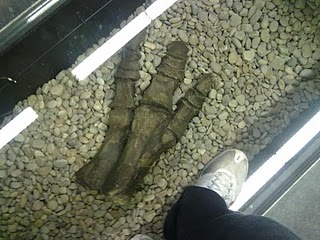Here is the tooth of an extinct "megalodon" shark (Charcharodon megalodon).
The fossilised foot of the dinosaur Lambeosaurus.
My hair being chewed on by a sable antelope (Hippotragus niger spp.). Just kidding, it was mounted and behind glass!
Me with a mounted penguin (family
Spheniscidae), situated nearby the mounted sable antelope in the Museum.
Spheniscidae), situated nearby the mounted sable antelope in the Museum.
Me with, from left to right, a preserved elephant shrew, baby crocodillian, and bat (family Macroscelididae, order Crocodilia, and order Chiroptera, respectively).
Me with the preserved wrasses and parrotfishes (families listed above).
And now for a picture from the C.K. Choi Building:
Me with the preserved wrasses and parrotfishes (families listed above).
And now for a picture from the C.K. Choi Building:
One of my partners in the biology 11 UBC fieldtrip scavenger hunt standing in front of one of the C.K. Choi Building's recycled brick walls.

















